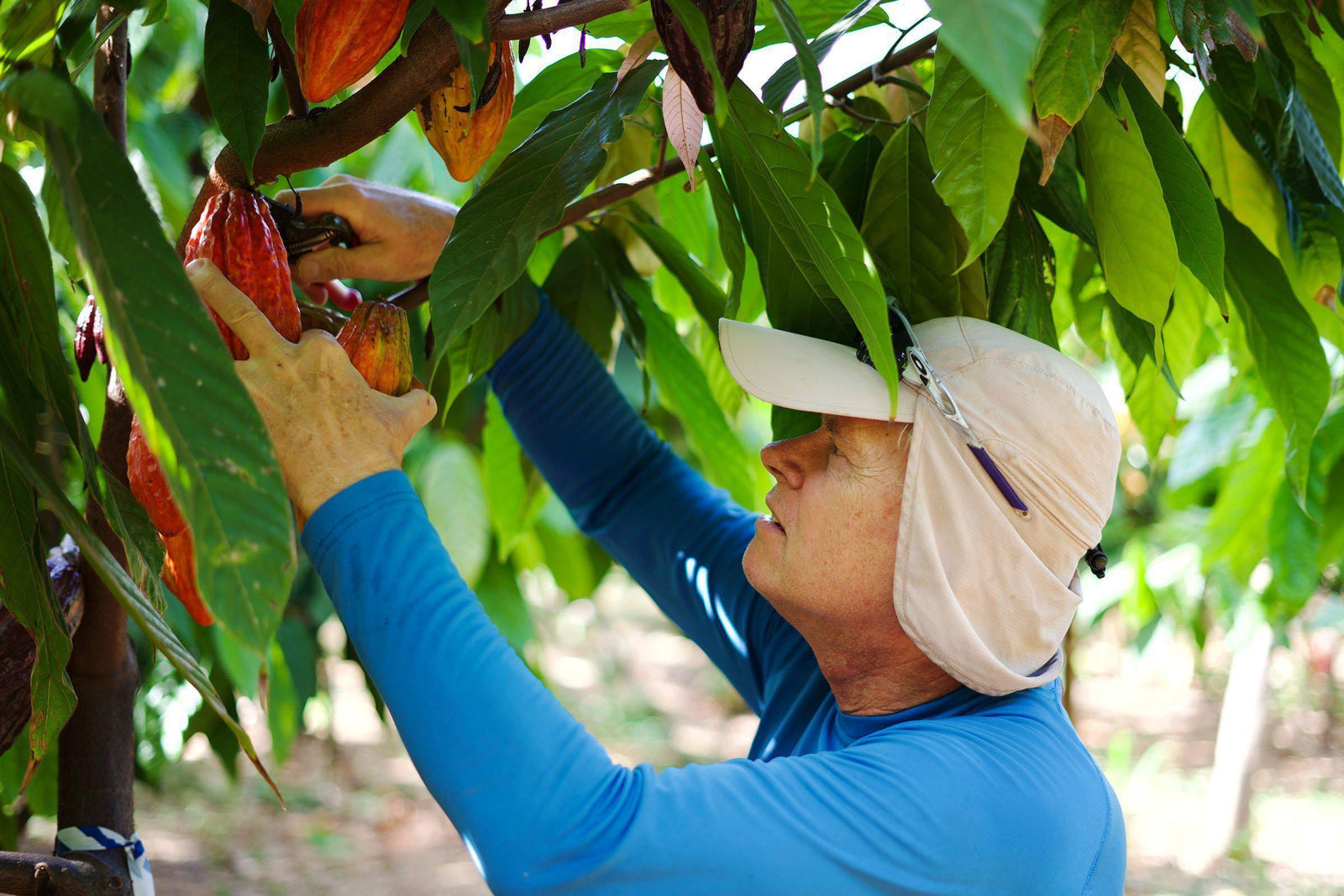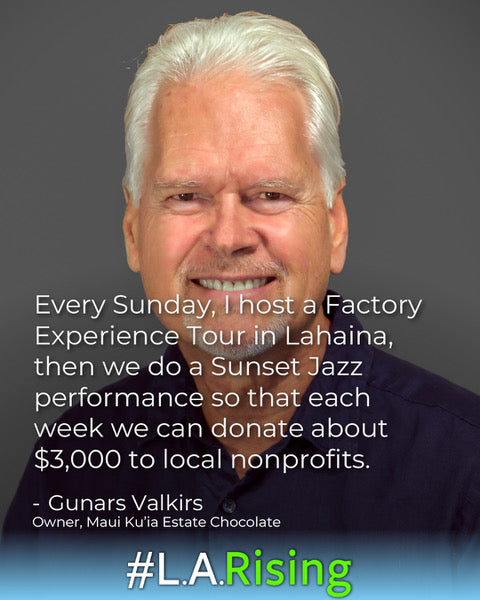
“The juice starts to ferment quickly,” Dan O’Doherty, VP of Chocolate Operations, tells me looking at a 5-gallon bucket of cloudy cacao juice sitting below a mesh bag of freshly harvest cacao seeds. The harvest is about halfway done and marching ahead at constant velocity. This is the Maui Kuʻia Estate Cacao Farm in Lahaina where the cacao is grown that will become the chocolate produced at the Kuʻia factory across town.

Gunars Valkirs clips a cacao pod - Photo : Nainoa Moore
This is my first time on the farm. You get there by driving onto a dirt road that looks to lead nowhere. About 5 minutes into the ride, I stop to make a call to confirm that I am in fact heading down the right dirt road. The dirt is red from the oxidized iron in the volcanic soil and dusty from the lack of rain.
During the harvest, ripe cacao pods—a collage of greens, reds, and yellows—are clipped from the trees by hand and loaded onto a 4-wheel-drive Kawasaki mule. The pods are then gathered in a pile where the farm workers and a small group of volunteers—about 12 people in total—sit around separating the seeds from the pod’s husk. Gunars Valkirs, the CEO of this chocolate enterprise, sits there as well, working with a small machete to split the cacao pods apart. Pockets of talk thrive between 2 or 3 nodes of the group at a time; occasionally and organically, a single conversation erupts among the workers before ebbing back. All the while, the hands work, creating a rhythm. Like a drum circle, the beat creates itself.

The work of opening the pods creates a natural rhythm and flow - Photo : Nainoa Moore
The workers and volunteers arrange themselves in pairs. One person whacks a machete into the 1/4-inch thick wall of the cacao pod and then twists the blade to pry the pod open, revealing white seeds inside. The broken pod is then passed to a partner who discards the husk and pulls out the seeds, placing them in a plastic bucket. The machetes set the tempo for the conversation, only pausing for the frequent bursts of laughter at whatever joke just landed. I stand by watching, feeling awkward that I don’t have anything to do with my hands except take notes, and I am grateful when Palani Wright, one of four full-time cacao farmers, includes me in the banter. One of the buckets fills up with seeds and is poured into mesh bag that hangs from a nearby tree to drain the juice into another bucket. David McPherson, the farm manager, offers me a taste. The cacao juice is bright, fruity, acidic—very similar to lychee. Delicious. Gunars continues to chat and whack cacao pods, cracking them open, and passing them on.
The seeds, held together by a white gooey fibrous structure, remain in a single unit when pulled out of the pod, but they break apart easily in my hands. The cacao pods are about the size of a papaya, and the seeds remind me of slightly too large fava beans. And when I hold a seed between my fingers, it is more slippery than I expect and flies away when I squeeze it. The slippery texture reminds me of okra. Dan says that, in fact, okra is distantly related to cacao—and so is hibiscus he adds. The seeds leave my fingers slimy, but when the juice dries, the residue is tacky, like glue.

One person opens the pod, and a partner removes cacao seeds - Photo : Nainoa Moore
The white pulp sticks to the seeds and makes the seeds appear white, but they are actually a dark purple. I taste one of them—bitter and an after taste that just barely hints at chocolate. Many of the tastes that we associate with the chocolate come from the fermentation and roasting.
Dan tells me that cacao is centuries behind other crops in terms of sophistication. Starting in the late 1800’s, witch’s broom fungus plagued cacao yields throughout South America. In the 1930’s, researchers from Trinidad went to the Peruvian Amazon in search of resistant strains of cacao. The descendants of these trees were used to create various hybrids that are now cultivated on farms all over the world. This was the last time wild cacao germplasm was introduced into the breeding pool. Now, most of the cacao in the world is grown on smallholder farms about 2 acre to 5 acres large in West Africa. And most of this chocolate is sold on a commodity market, which neither penalizes nor rewards differences in quality. This means that what we think of as chocolate—the chocolate that we grew up eating—is the lowest common denominator in terms of quality. The low prices paid on the global commodity market remove incentive from these farms to improve their quality.
The farm here on Maui is a major attempt to curate and farm cacao with intention and science—similar to the way that wine grapes are grown. Dan walks me on a tour of the farm. The fields are hot despite the shade trees. The environment is much drier than the Amazonian Basin where cacao originates. I ask Dan about the harsher environment in Lahaina, and he says that the stress from the drier, sunnier climate creates a stronger flavor profile in the cacao, concentrating the taste. Right now, the farm grows many varietals of cacao, and the best performing trees will be grafted into the future fields, further curating the cacao.

Cacao beans are ready to start the fermentation process - Photo: Nainoa Moore
Walking back, the workers and volunteers are already done emptying the pods. Gunars has left. The harvest is now over, and the fermentation, which is actually one of the most important parts of the chocolate process, is just getting started. The seeds will be placed in wood crates to ferment. As I walk back to the farm entrance, the crew share beers, and they invite me to join. I ask what will happen to the big pile of empty husks. They will be composted and then used to fertilize the fields, returning nutrients, like potassium, to the soil.
Because of the rarity and limited quantity of the cacao from our Maui Kuʻia Estate Cacao Farm, chocolate made from our current harvests will only be available to Kuʻia Chocolate Club members at this time. We encourage you to sign up to join the Kuʻia Chocolate Club.





Leave a comment (all fields required)